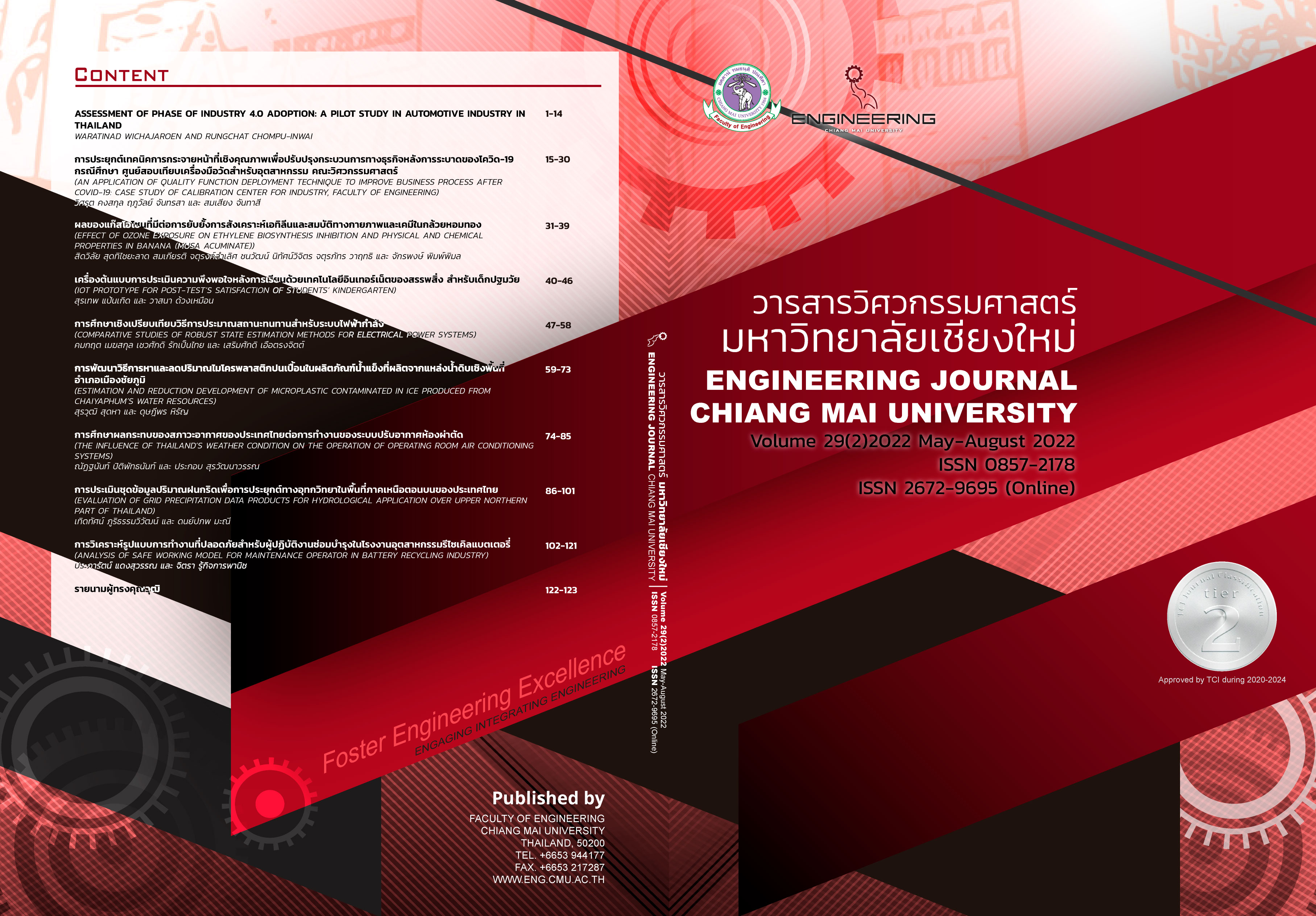Analysis of safe working model for maintenance operator in battery recycling industry
Keywords:
Hazard risks of maintenance operators, Hazard of exposure to lead, Battery recycling industries, Lead exposureAbstract
Maintenance operators in the battery manufacturing and battery recycling industries are at an increased risk of lead poisoning which also contaminates the atmosphere and workspace. The objective of this research is to analyze the working patterns of safety of maintenance operators. Conducting research starts from 1) Measurement of the operating environment Observing the behavior Observing work behavior and lead exposure channels. 2) Hazard risk assessment using FMEA as a risk assessment guideline to analyze safe working patterns. The results showed that the channels of exposure to the body are 1) the respiratory system through inhalation of fumes, dust, vapors, 2) skin contact from liquids contaminated with lead, and 3) the gastrointestinal tract from lead-contaminated hands and bodies. Factors affecting lead exposure according to chance of exposure are as follows: 1) lead dust dispersion 2) heat sources causing lead vapor, 3) wet area from lead contaminated liquid, 4) work behavior, 5) working period, and 6) meal breaks. Preventive measures include 1) installation of equipment to prevent the spread of lead dust, 2) creation of a heat shield from lead vapor, 3) using accessories to facilitate the work of maintenance operators, 4) scheduling work efficiently to reduce working time exposed to heat, and 5) wearing protective clothing. Surveillance measures are divided into threat surveillance measures and health surveillance measures. After taking measurements for a period of ten months, it was found that lead in the maintenance operator’s blood was reduced from 461.70 µg/L (46.17 µg/dL) to 157.40 µg/L (15.74 µg/dL), which is within the normal range.
References
กองโรคจากการประกอบอาชีพและสิ่งแวดล้อม กรมควบคุมโรค กระทรวงสาธารณสุข, แนวทางการเฝ้าระวัง ป้องกัน ควบคุมโรคพิษตะกั่วในกลุ่มวัยแรงงาน. กรุงเทพฯ: อักษรกราฟฟิคแอนด์ดีไซน์, 2563.
S. M. Levin, M. Goldberg, J. T. Doucette, “The effect of the OSHA lead exposure in construction standard on blood lead levels among iron workers employed in bridge rehabilitation,” American journal of industrial medicine, vol.31, no.3, Mar., pp. 303-309, 1997.
R. M. Thomson and G. J. Parry, “Neuropathies associated with excessive exposure to lead,” Muscle Nerve, vol. 33, no. 6, Jun., pp. 732–741, 2006.
M. F. Soto-Jiménez and A. R. Flegal, “Metal-contaminated indoor and outdoor housedust from a neighborhood Smelter area in Torreón, Mexico” Procedia Environmental Sciences, vol. 4, Jan., pp. 134–137, 2011.
มธุรส รุจิรวัฒน์ และ จุฑามาศ สัตยาวิวัฒน์, พิษวิทยาสิ่งแวดล้อม. กรุงเทพฯ: ทรินิตี้ พับลิชชิ่ง, 2549.
Patrick, L, “Lead Toxicity, a review of the literature. Part I: Exposure, Evaluation, and treatment,” Alternative Medicine Review, vol.11, no.1, pp. 2-22, 2006.
วิทยา อยู่สุข, อาชีวอนามัยและความปลอดภัย. พิมพ์ครั้งที่ 4, กรุงเทพฯ: ภาควิชาอาชีวอนามัยและความปลอดภัย คณะสาธารณสุขศาสตร์ มหาวิทยาลัยมหิดล. 2552.
K. C. STAUDINGER and V. S. ROTH, “Occupational Lead Poisoning,” Am. Fam. Physician, vol. 57, no. 4, pp. 719–726, 1998.
S. M. Levin, M. Goldberg and J. T. Doucette, “The effect of the OSHA lead exposure in construction standard on blood lead levels among iron workers employed in bridge rehabilitation,” American journal of industrial medicine, vol. 31, no. 3, pp. 303–309, 1997.
จิตรา รู้กิจการพานิช, วิศวกรรมความปลอดภัย สำหรับวิศวกรรมอุตสาหการ. กรุงเทพฯ: สำนักพิมพ์แห่งจุฬาลงกรณ์มหาวิทยาลัย, 2561.
จุรีพร สุวรรณสา, “การประยุกต์ระบบบริหารความเสี่ยง (ISO31000) สำหรับการผลิตตัวเร่งปฏิกิริยาในไส้กรองไอเสียรถยนต์,” วิทยานิพนธ์ วิศวกรรมศาสตรมหาบัณฑิต, จุฬาลงกรณ์มหาวิทยาลัย, 2553.
จิตรา รู้กิจการพานิช, การออกแบบการทำงาน คู่มือสำหรับนิสิตนักศึกษา วิศวกร หัวหน้างาน เจ้าของกิจการ. กรุงเทพฯ: สำนักพิมพ์แห่งจุฬาลงกรณ์มหาวิทยาลัย, 2557.
C. A. Ericson and others, Hazard analysis techniques for system safety. Hoboken. John Wiley & Sons, 2015.
N. Salter, “Implementation of the Hazards and Effects management Process (HEMP) at Shell Chemical Facilities,” in The 7 th World Congress of Chemical Engineers, 2005, pp. 1-10.
H.Lingard and S.Rowlinson, Occupational health and safety in construction project management. London: Routledge. 2005.
A. P. Subriadi, N. F. Najwa, B. D. Cahyabuana and V. Lukitosari, "The Consistency of Using Failure Mode Effect Analysis (FMEA) on Risk Assessment of Information Technology," in 2018 International Seminar on Research of Information Technology and Intelligent Systems (ISRITI), in 2018, pp. 61-66.
Downloads
Published
Issue
Section
License
ลิขสิทธิ์ของบทความที่ตีพิมพ์ในวารสารฉบับนี้จะยังเป็นของผู้แต่งและยินยอมให้สิทธิ์เผยแพร่กับทางวารสาร
การเผยแพร่ในระบบวารสารแบบเปิดนี้ บทความจะสามารถนำไปใช้ได้ฟรีในการศึกษา และในทางที่ไม่เกี่ยวกับการค้า




